Abstract
Building management systems are costly for small- to medium-sized buildings. A massive volume of data is collected on different building contexts by the Internet of Things (IoT), which is then further monitored. This intelligence is integrated into building management systems (BMSs) for energy consumption management in a cost-effective manner. Electric fire safety is paramount in buildings, especially in hospitals. Facility managers focus on fire protection strategies and identify where system upgrades are needed to maintain existing technologies. Furthermore, BMSs in hospitals should minimize patient disruption and be immune to nuisance alarms. This paper proposes an intelligent detection technology for electric fires based on multi-information fusion for green buildings. The system model was established by using fuzzy logic reasoning. The extracted multi-information fusion was used to detect the arc fault, which often causes electrical fires in the low-voltage distribution system of green buildings. The reliability of the established multi-information fusion model was verified by simulation. Using fuzzy logic reasoning and the membership function in fuzzy set theory to solve the uncertain relationship between faults and symptoms is a widely applied method. In order to realize the early prediction and precise diagnosis of faults, a fuzzy reasoning system was applied to analyze the arcs causing electrical fires in the lines. In order to accurately identify the fault arcs that easily cause electrical fires in low-voltage distribution systems for building management, this paper introduces in detail a fault identification method based on multi-information fusion, which can consolidate the complementary advantages of different types of judgment. The results demonstrate that the multi-information fusion method reduces the deficiency of a single criterion in fault arc detection and prevents electrical fires in green buildings more comprehensively and accurately. For the real-time dataset, the data results are presented, showing disagreements among the testing methods.
1. Introduction
The safe use of electricity has become one of the eternal themes of China’s power industry development. How to effectively detect the cause of an electrical fire and reduce the incidence of electrical fire accidents that cause loss of life and property has become the focus of research on electricity safety in today’s society. Multi-information fusion technology is a functional simulation of the complex treatment of the human brain. The aim is to provide an advanced and reliable method for solving information processing and decision-making problems in the information age [1]. It mainly uses computer technology to synthesize, analyze, and process multiple units of the information under specific criteria derived from expert experience or experimental results, complementing them in space and time, eliminating redundant information, and ultimately achieving the desired decisions and tasks [2]. It has been proven that buildings consume 60% of total global electricity and are the major electricity consumers. Buildings consume 70% of the annual electricity in the United States [3]. There is a great need for a significant push towards developing an effective building management system (BMS) to manage electricity in buildings effectively. Figure 1 shows a scenario for the Internet of Things (IoT)-based green building management that leverages sensor fusion and machine learning.
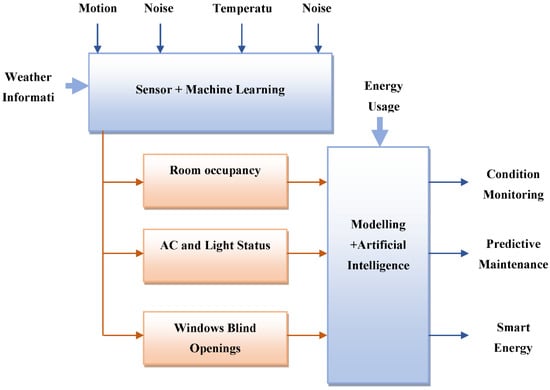
Figure 1.
An Internet of Things (IoT)-based green building management scenario that uses sensor fusion and machine learning.
Existing BMSs are expensive and not feasible for buildings of small and medium size. Building administrators should consider the dynamic and various necessities of buildings—such as irregularity detection, predictive maintenance, and residency tracking—to minimize electricity consumption and upsurge operational efficiency. The Occupational Safety and Health Administration (OSHA) provides standards for the control of heating, ventilation, and air conditioning (HVAC). If sensors are not used, rooms are ventilated after a routine period based on the number of people in the rooms. Hence, this process causes wastage of energy. BMSs with intelligence capabilities apply sensing to provide improved situational awareness and higher adaptive and dynamic managing of electricity and energy storage devices. In this case, the IoT is a potential solution that can support this integration. A report from the United Nations Environment Program has shown that the building industry consumes 30–40% of the world’s energy [4,5,6].
Meanwhile, China’s building industry accounts for 38% of social energy consumption [7,8,9]. Industries are also struggling to find green and sustainable means of development. Hence, there is a fundamental need for the building industry to discover and develop a sustainable development model in order to transform the present state of larger resource consumption. Mass notification systems and the IoT help to advance the evolution of fire safety systems [10,11].
A building consumes energy through original embodied energy, periodic embodied energy, operational energy, and destruction energy.
- Initial embodied energy refers to the consumption of energy in several activities involved in the construction of a building, including extraction, processing, and manufacture.
- Periodic embodied energy is consumed by renovating and sustaining the building during its life.
- Operational energy involves the consumption of energy by appliances for heating, cooling, and powering.
- The demolition of a building requires destruction energy.
Contribution: The innovation of this paper is the analysis and comparison, using fuzzy logic reasoning method, and the fault arc identification and reasoning system are established.
- The fuzzy rules determined by many experiments and expert experience can be modified and adjusted at any time to establish an accurate expert database for fault diagnosis.
- The fault identification results on MATLAB are consistent with human logical reasoning ability.
- Identification is accomplished of the fault arcs which quickly cause electrical fires in low-voltage distribution systems for building detection.
- The fault identification method based on multi-information fusion is detailed to achieve the purpose of each judgment’s complementary advantages.
2. Literature Review
In this paper, the background and significance of the research, the characteristics of electrical fires, the leading causes of electrical fires, the current protection devices’ current situation, and technical measures for preventing electrical fires at home and abroad are reviewed [12,13,14]. The existing standard specifications for preventing electrical fires are reviewed, and the key issues to be solved. Gao is analyzed in depth. A. indicates that when the fault point breaks out an arc or an electric spark, it generates abnormal high temperature. The center temperature of a few safety arcs can reach 2000 or 4000 degrees centigrade [15,16,17]. Due to the limitation of the impedance, the fault current is small, which is not enough to make the overcurrent protection device act; the fault arc continues to occur, frequent ignition and arcing can directly ignite the combustible material near the electrical circuit or equipment, which is a particularly dangerous source of ignition. The risk of fire is far greater than that of a metal short circuit [18]. Hong, W. said that the national electrical law NEC of the United States estimated that about 40% of residential fires are caused by “fault arcs” [19]. Xinhua, J. has analyzed in detail the reasons why conventional short-circuit protection cannot fully protect the fault arcs. This results in a long reaction time of upstream circuit breakers or fuses, which cannot be divided in time, and causes severe accidents in person and equipment [20]. For example, the GB50045-2005 code for tall buildings’ fire protection design should be set up by the high regulations, where fire hazards are high for crowded places in high-rise buildings. The code of residential design issued by China has also specified that the circuit breaker with residual current protection function should be installed at the inlet of residential buildings’ total power supply [21]. At present, it has been installed. The residual current protector has been widely applied. Many residual current protectors can realize independent alarms and do not need to connect with the controller [22]. Tushar et al. proposed signal processing and machine learning techniques in IoT-based BMS by addressing the research gaps of existing BMSs that are very costly and difficult to consider for small- and medium-sized buildings [23]. The authors described how to extract occupancy information of elevated buildings using inexpensive IoT sensors. Shi & Liu systematically analyzed and visualized the green building. The authors analyzed the green building’s current knowledge system considering CiteSpace based on Web of Science (WoS) [24]. Clusters and citation bursts analysis is done, and based on these keywords, the authors developed a knowledge graph to represent a green building. The status quo and development trend of green building and easier identifying the deficiencies in green building development. Pramanik proposed to merge green and smart technologies to make the green smart building (GSB) to provide a smart and eco-friendly living to society [25]. The GSB concept is detailed suitably, which supports the architectural models of a GSB. Diverse entities and functions in various communication levels among different digital components of a GSB are presented. The authors also presented the real applications of green and smart technologies in buildings. Rameshwar et al. presented comprehensive and significant research conducted to date with regard to green buildings. In-depth analysis of design technologies that lay a strong foundation for green building has been detailed. The smart automation technologies are also highlighted, which help in energy conservation along with various performance parameters [26]. In this paper, Asadian et al. proposed a multi-criteria framework composed of sixty-eight sub-factors on the core level. Eight quality condition components are considered on the secondary level alongside energy, space flexibility, cost-effectiveness, client comfort, working efficiency, safety, culture, and technology. The first includes a multi-criteria model in the design process to define all factors, and the second proposes a conceptual model for reducing carbon dioxide emissions [27].
Early detection and alarm are realized in a building fire alarm system by the multi-sensor and information fusion technology [28]. The range of fire monitoring in space and time is expanded by utilizing the multi-sensor to monitor the parameters such as light, smoke, temperature, gas, and moisture, the range of fire monitoring in space and time. The D-S evidence theory fuses the multi-sensor information with the specific fire model for accurate and in-time fire alarm. The monitoring data’s failure is avoided by the presented technique effectively to significantly improve fire warnings’ reliability. The fire monitoring and safety management system are important applications in IoT technology [29]. The research and development of IoT are provided in the firefighting, monitoring, and safety management field. Intelligent fire monitoring systems require an accurate and effective firefighting software design. For fire monitoring, critical issues of wireless sensor network hardware and software are discussed. The function of each module is discussed and implemented by the authors. The application features of IoT technology is discussed according to firefighting requirement. A new method is proposed for modeling human reasoning about objects’ similarities [30]. The authors showed the method to find the underlying structure of the matrix with intensities of objects. The demonstrated approach is fuzzy logic-based, and only maximum and minimum operators are utilized. The decomposition in practice applied to exemplary data from classic psychological found by the heuristic algorithms. The experiments that had undermined traditional human reasoning models are explained by the fuzzy logic as detailed by the authors [31]. The fuzzy logic with some paradoxes of classical logic is confronted when it tries to model human reasoning. The fuzzy logic reduces the threshold problems, and authors also express a neuro-fuzzy system. Further analysis is required by the Wason selection task focusing on fuzzy modus ponens and modus tollens.
Research Gap: Multi-information fusion technology is a functional simulation of the complex treatment of the human brain. The aim is to provide an advanced and reliable method for solving the information processing and decision-making problems in the information age. There is a great need for a significant push towards developing to effectively manage the electricity in buildings through efficient building management systems.
3. Research Methods
In view of the causes of the frequent occurrence of electrical fires and the investigation and study of the existing protective devices against electric fires in the market, it is concluded that the effective protection measures for preventing electrical fires in low-voltage distribution systems in buildings are based on the original fuse, overload, under-voltage protection, and residual current protection devices. The fault arcs easily causing electrical fires should be regarded as the key monitoring objects [28]. To accurately identify the fault arcs that easily cause electrical fires in low-voltage distribution systems for building detection, this paper introduces in detail the fault identification method based on multi information fusion to achieve the purpose of complementary advantages of each judgment. Figure 2 shows the direct causes of large and major fires in recent years.
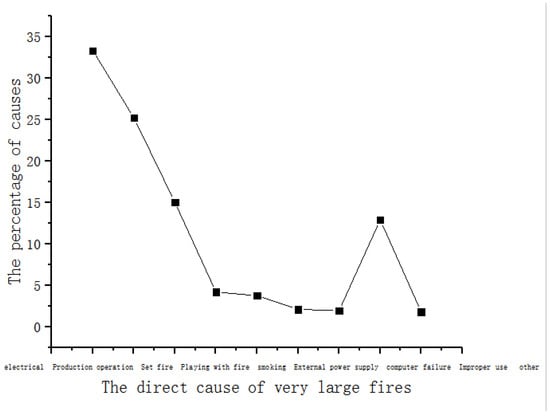
Figure 2.
Direct causes of large and major fires in recent years.
As can be seen from Figure 2, the largest and most serious fires caused by electrical failures in the year to year major fires are the largest. From this, it can be seen that electrical fires are the first of all kinds of fires, regardless of the quantity of loss they cause. Electrical fires are closely related to daily human life. It will cause significant harm to people’s lives and property and bring instability to social stability and national economic development. Electricity can not only benefit mankind, but also bring unexpected harm to mankind. Therefore, effective measures should be taken to detect the electrical fire’s cause, so it is urgent to prevent electric fires.
3.1. Multi Information Fusion Method
The commonly used information fusion methods include the weighted average method, Kalman filtering method, Bias estimation method, evidence reasoning, genetic algorithm, rough set theory, expert system, fuzzy logic reasoning, neural network, etc. Scholars have paid expert systems, fuzzy logic inference, and neural networks much attention to their artificial intelligence characteristics. It has been applied in many fields [32,33,34,35]. After collecting the fire characteristics parameters of information, the data fusion layer processes the data. Based on data layer data processing, layer characteristics of fusion are conducted. Decision-making information is also merged with the decision-making fusion. Multi-field information is the output of decision-making [36]. Fire dynamics simulators are utilized for training and validation to build a variety of fire scenarios.
The multi-sensor data fusion technology has aroused widespread interest both domestically and abroad, and many fruitful results have been achieved. The Multi-sensor information fusion improves system reliability by increasing the measurement credibility and applied to a wide variety of military and industrial fields like control of autonomous vehicles, robotics, industrial process control, medical diagnostics, and image processing [37,38]. Multi-sensor data fusion has many methods, and the classical inference, Kalman filter, Bayes estimation method are the main sophisticated ones.
3.2. Fuzzy Logic Inference System Based Fault Arc Detection
Fuzziness is used to describe the uncertainty and imprecision of events. The fuzzy system imitates human’s fuzzy comprehensive judgment ability. Fuzzy logic reasoning represents many experimental results, experts’ experience, or knowledge of language control rules. These rules are used to realize the logical reasoning or control of mathematical models with unknown, complex, or nonlinear systems using traditional models too complicated [39,40,41,42,43,44].
The fuzzy logic inference system consists of four parts, as shown in Figure 3:

Figure 3.
Schematic diagram of the fuzzy logic reasoning system.
- Fuzzification
- Fuzzy rule base
- Fuzzy logic inference
- De-fuzzification
The graph shows that the fuzzy logic inference system defines a nonlinear relationship between input variables and output variables. X and y are input and output of fuzzy logic inference systems, respectively. They are all non-fuzzy quantities. Because fuzzy logic inference system is based on fuzzy sets, data processing is based on fuzzy sets. Fuzzification is to transform non-fuzzy input variables into fuzzy sets on input and output fields, mapping the input space into the fuzzy set on the input domain, which plays a vital role in the fuzzy inference system.
3.3. Simulation Study of Fuzzy Logic Inference System Based Fault Arc Detection
The fuzzy logic inference function is to deal with fuzzy rules matching based on fuzzy logic operation and fuzzy input information. According to different rules of the activation rule library, the corresponding output results can be obtained. The process of ambiguity resolution and fuzzification is precisely the opposite. It transforms the fuzzy output of the fuzzy inference system into a specific physical meaning [45,46,47,48,49]. The commonly used de-fuzzification methods include the gravity method, weighted summation method, area center method, and so on.
In fault diagnosis, the relationship between input and output has some degree of uncertainty. Using fuzzy logic reasoning and membership function in fuzzy set theory to solve the uncertain relationship between faults and symptoms is a widely applied method. In order to realize the early prediction and precise diagnosis of faults, the fuzzy reasoning system is applied to analyze the arcs causing electrical fires in the lines. Firstly, according to a large number of experimental results and expert experience, the characteristic quantities of the arc fault are extracted, and the validity and defects of each characteristic quantity as the criterion are determined. The influence of each criterion on the overall failure probability judgment is judged [50,51,52,53]. The fuzzy rules for identifying fault arcs are established as knowledge in the knowledge base so that the results of fuzzy reasoning conform to the actual situation. Secondly, based on the extracted fault arc characteristics, data fusion is preprocessed to obtain comprehensive information for identifying the fault arcs [54,55,56]. Finally, according to the collected signal characteristics, the fuzzy logic inference system uses the forward reasoning method to establish the fuzzy logic system to identify the fault arcs and make real-time inferences for the failure’s probability.
- Fuzzification: The probability of fault arc is evaluated by fuzzy mathematics as shown in Equation (1).
The probability of fault arc is evaluated by fuzzy mathematics. Firstly, three input characteristics x = {x1, x2, x3} fuzzy sets of fault arcs are defined, A = {A1, A2, and A(A)} are used to represent the fuzzy set, which accurately reflects the probability of occurrence of arc fault when each input characteristic quantity occurs. The function is the membership function of the input variables, and the fuzzy set A on x can be expressed as in Equation (2):
The summation sign in the formula is not a summation. It represents the fuzzy set of all input variables with the membership function μi of the input characteristic quantity X. The fuzzy set of the output variable failure probability is B. The membership function is . The membership functions of fuzzy input and output variables can be chosen as a trapezoid, Gauss type, triangle, or other shapes. The selection of membership functions and the determination of initial values are based on experience. Then, it is determined according to the test and simulation results. In this paper, the description of the failure probability size is described using the language of the large, medium, small, and no-fault possibilities. The membership functions of the three input variables and the output fault probability are divided into four language variables: the fault is large, the fault is partial, the fault is small, and the fault is represented in English abbreviation {pb, PM, PS.Zo}. This adopts a triangular distribution function that is simple in shape, easy to calculate, and widely used, and a descending trapezoid distribution function and a lifting half trapezoid distribution function often used to describe the partial or small relation are shown in Equation (3). The Triangle membership function curve is shown in Figure 4.
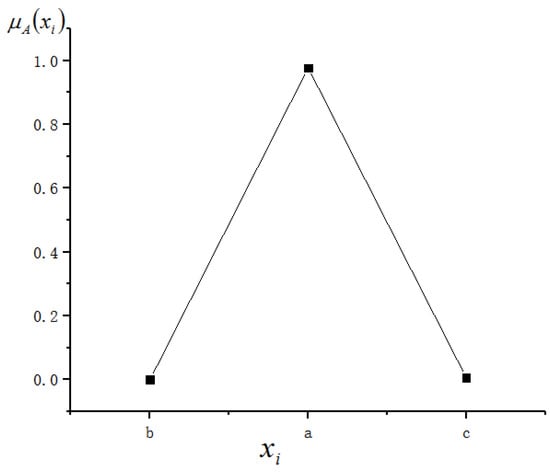
Figure 4.
Triangle membership function curve.
- ii.
- Establishing fuzzy inference rules
The fault arc detection system based on fuzzy logic reasoning is a multi-input and single output structure and adopts “IF and…Then…” rule form description implemented by fuzzy logic reasoning, described by fuzzy conditional statements. The fuzzy reasoning rules described in this series of fuzzy conditions constitute the fuzzy logic inference rule.
The fuzzy logic toolbox in MATLAB software can observe and modify the membership functions of various variables in the fuzzy logic reasoning system and the fuzzy inference rules of the system conveniently and intuitively. In this paper, the fuzzy reasoning system is simulated by using the toolbox.
There are five primary graphical user interfaces in the fuzzy logic toolbox, which can be used to establish, edit, and observe the fuzzy inference system. It contains three editors and two observers. The simulation uses Mamdani fuzzy logic reasoning method and uses fuzzy reasoning system (FIS) in the fuzzy toolbox to establish fuzzy rules. For example, according to the experimental analysis, the high-frequency coefficient D1 of the wavelet has a large amplitude. Simultaneously, the difference between the mean value of each cycle and the amplitude of the waveform slope exceeds a specific closed value. Then a fault arc cycle can be determined. The rule can be expressed as follows IF (the difference between the mean of sampling is PB) AND (slope is PB) AND (high-frequency wavelet coefficient is PB) THEN (failure probability is PB).
- iii.
- Fuzzy rules are set up
If (mean difference is PS) and (slope is ZO) and (wavelet coefficient is ZO)
then (failure probability is ZO).
If (mean difference is PS) and (slope is PM) and (wavelet coefficient is ZO)
then (failure probability is PS).
If (mean difference is PB) and (slope is PS) and (wavelet coefficient is PM)
then (failure probability is PB).
If (mean difference is ZO) and (slope is PB) and (wavelet coefficient is ZO)
then (failure probability is PM).
If (mean difference is PM) and (slope is PS) and (wavelet coefficient is ZO)
then (failure probability is PS).
If (mean difference is PM) and (slope is PB) and (wavelet coefficient is PM)
then (failure probability is PB).
If (mean difference is PM) and (slope is PM) and (wavelet coefficient is PB)
then (failure probability is PB).
If (mean difference is PS) and (slope is PS) and (wavelet coefficient is PB)
then (failure probability is PM).
If (mean difference is PS) and (slope is PM) and (wavelet coefficient is ZO)
then (failure probability is PS).
If (mean difference is PB) and (slope is PB) and (wavelet coefficient is PM)
then (failure probability is PB).
The input and output surface view window of the fuzzy logic toolbox can directly display the corresponding relationship between the fuzzy logic inference system’s input and output.
4. Results and Discussion
4.1. Ambiguity Resolution
Using the most commonly used anti de-fuzzification method, the centroid method (moment method) is used as a fuzzy solution in this paper. Its characteristic is to consider the information of fuzzy quantity and calculate it more easily by Equation (4), as shown below.
is the membership function of output variables.
4.2. Fuzzy Logic Reasoning Results
In the fuzzy toolbox, the output of the corresponding fault probability can be obtained by changing the input feature’s size on the view of the fuzzy detector. Thus, it is reasonable to determine whether the fuzzy rule is reasonable. Whether the fuzzy logic inference system can detect the fault arc cycle accurately is listed. The output of the failure probability corresponding to ten different input values is enumerated in Table 1.

Table 1.
Results of fuzzy inference system.
The analysis shows that the results in Table 1 are in line with the actual situation. It shows that the fuzzy logic inference system can simulate human thinking reasoning very well and fuse the three kinds of input information to extract useful information to identify the arc period. A total of 10 inputs are taken and obtain the results in terms of different parameters. There is variation in the obtained output at varying inputs. Variation in the output in terms of various parameters is effectively represented in terms of graphs in which every point is shown clearly. The results in terms of mean difference, probability, slope, and wavelet coefficients are graphically represented in Figure 5, Figure 6, Figure 7 and Figure 8.
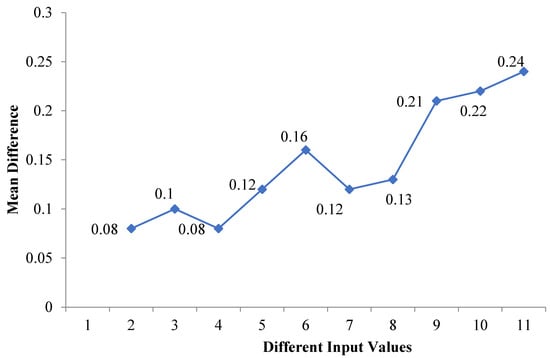
Figure 5.
Mean difference values corresponding to ten different input values.
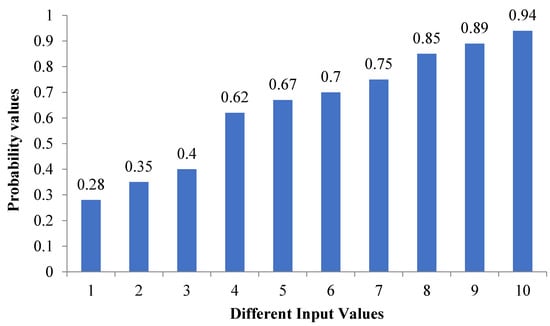
Figure 6.
Probability values corresponding to ten different input values.
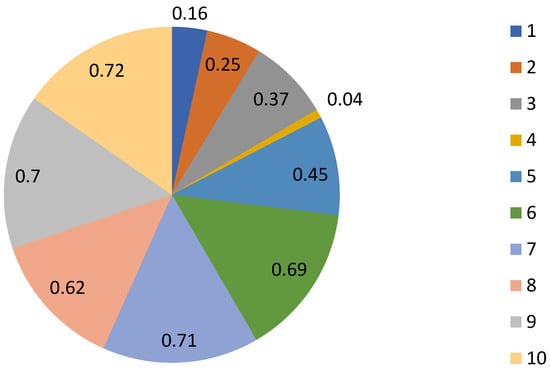
Figure 7.
The slope values corresponding to ten different input values.
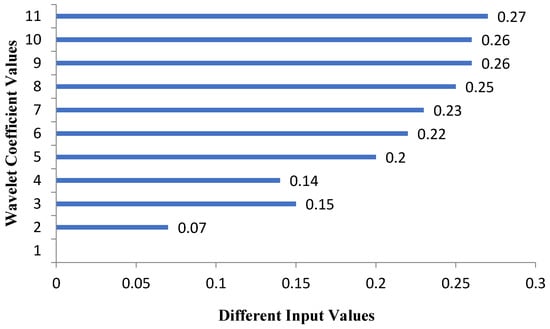
Figure 8.
The wavelet coefficient values corresponding to ten different input values.
These various parameters obtained for the ten inputs show the effectiveness of the presented method. The values in terms of different performance metrics are obtained efficiently in terms of mean difference, slope, wavelet coefficients, and probability.
The existing protection devices for low-voltage distribution systems in the buildings cannot detect the fault arcs that easily cause electrical fires. There are some loopholes in preventing electrical fires, resulting in the continuous occurrence of electrical fires and the great threat to people’s lives and property safety.
Based on reading many documents and communicating with the Architectural Design Institute, the leading causes and defects of the electrical fire are identified, and the fault identification model and fuzzy rule base are established, and the essential contents are studied. However, due to the limitation of research time, experimental conditions, and design experience, there are still many deficiencies, so electrical fire’s intelligent detection technology should be commercialization. The main problems in the research process are as follows: (1) In the fault arc simulation field, there are no corresponding standards in China to regulate the specific experimental environment and experimental equipment of the fault arc generator. After reading many documents, this paper refers to the foreign standards, combined with the causes of aging and poor contact in the actual circuit.
Due to the limitation of the experimental conditions, this paper only simulates several representative load circuits and the situation of the load changes. It further researches other nonlinear load conditions that often exist in the circuit because of the limitation of experimental conditions. The other main problems are (2) in fully distinguishing the similarities and differences between fault arc characteristics and nonlinear load, and (3) in studying the intelligent detection technology of electrical fire. This research mainly includes experimental platform construction, data collection and analysis, and simulation verification of multi-information fusion.
Results are also obtained for the real-time dataset, and Table 2 presents the data showing the disagreements among the testing methods. By dividing the disagreement count, percent disagreement was calculated by the number of the tested samples. The graphical representation of the disagreements among the testing methods is shown in Figure 9.

Table 2.
Disagreements among the testing methods.

Figure 9.
Disagreements among the testing methods.
The FIS and the disagreement amount between the classifiers have decreased considerably; there are consistent FIS results for the consecutive years. FIS disagreement was much more evenly spread between the white and light spotted classes, and there is no systematic bias in the FIS’s grading.
5. Conclusions
On the basis of the existing electric fire protection device, this paper adopts a multi-modality fusion method to detect the fault arcs in distribution lines that are easy to cause electrical fires in the low-voltage distribution systems of buildings. By setting up the experimental platform, using the current transformer and data acquisition module to collect experimental data, the fault’s main characteristics are analyzed, and the appropriate criterion is selected. Finally, fuzzy logic inference system is adopted to carry out multi-information fusion. It is concluded that the fuzzy logic inference system can achieve the function of simulating human thinking reasoning very well and fuse the three kinds of input information to extract useful information to identify the arc period. It is drawn from the obtained results that the multi-information fusion method can make up for the deficiency of a single criterion in fault arc detection and prevent electrical fires more comprehensively and accurately. The multi-sensor information fusion method to test parameters can estimate the value of distributing parameters. Any prior knowledge of sensor measurement data is not required to be known. Improvement is not only in the accuracy of measurement parameters but also in the stability and low computational complexity.
Author Contributions
Conceptualization, X.R. and C.L.; methodology, X.M. and F.C.; Software, F.C.; validation, X.M.; F.C., and H.W.; formal analysis, A.S. and G.S.G.; investigation, X.M.; F.C.; H.W., and A.S.; resources, X.R. and C.L.; data curation, F.C.; writing—original draft preparation, X.R.; C.L.; X.M.; F.C. and H.W.; writing—review and editing, A.S.; G.S.G. and M.M.; visualization, A.S. and G.S.G.; supervision, H.W.; A.S.; G.S.G. and M.M.; project administration, F.C. and H.W.; funding acquisition, M.M. All authors have read and agreed to the published version of the manuscript.
Funding
Taif University Researchers Supporting Project number (TURSP-2020/10), Taif University, Taif, Saudi Arabia.
Institutional Review Board Statement
Not Applicable.
Informed Consent Statement
Not Applicable.
Data Availability Statement
All data has been shared in this manuscript.
Acknowledgments
Authors would like to thank for the support of Taif University Researchers Supporting Project number (TURSP-2020/10), Taif University, Taif, Saudi Arabia, and Wuhan education and science project “Design and modeling of Multi Information Fusion based Intelligent Detection System of Green Building Electrical Fire” in Applied-Oriented Universities Taking Wuhan Business University.
Conflicts of Interest
Authors have no conflict of interest.
Ethics Approval and Consent to Participate
Not applicable.
Human and Animal Rights
No animals and humans were used for studies that are base of this research.
Consent for Publication
We give our consent for publication.
References
- Lei, L.; Cai, H.P.; Tang, T.; Su, Y. A MSA feature-based multiple targets association algorithm in remote sensing images. J. Remote Sens. 2008, 12, 586–592. [Google Scholar]
- Qi, F.; Tianjiang, W.; Fang, L.; HeFei, L. Research on multi-camera information fusion method for intelligent perception. Multimed. Tools Appl. 2018, 77, 15003–15026. [Google Scholar] [CrossRef]
- Bhutta, F.M. Application of smart energy technologies in building sector—Future prospects. In Proceedings of the 2017 International Conference on Energy Conservation and Efficiency (ICECE), Lahore, Pakistan, 22–23 November 2017; pp. 7–10. [Google Scholar]
- Abdallah, M.; El-Rayes, K.; Liu, L. Optimizing the selection of sustainability measures to minimize life-cycle cost of existing buildings. Can. J. Civ. Eng. 2016, 43, 151–163. [Google Scholar] [CrossRef]
- Sharma, A.; Singh, P.K.; Sharma, A.; Kumar, R. An efficient architecture for the accurate detection and monitoring of an event through the sky. Comput. Commun. 2019, 148, 115–128. [Google Scholar] [CrossRef]
- Rathee, G.; Sharma, A.; Saini, H.; Kumar, R.; Iqbal, R. A hybrid framework for multimedia data processing in IoT-healthcare using blockchain technology. Multimed. Tools Appl. 2019, 79, 1–23. [Google Scholar] [CrossRef]
- Lu, Y.; Cui, P.; Li, D. Which activities contribute most to building energy consumption in China? A hybrid LMDI decomposition analysis from year 2007 to 2015. Energy Build. 2018, 165, 259–269. [Google Scholar] [CrossRef]
- Sharma, A.; Kumar, R. Performance comparison and detailed study of AODV, DSDV, DSR, TORA and OLSR routing protocols in ad hoc networks. In Proceedings of the 2016 Fourth International Conference on Parallel, Distributed and Grid Computing (PDGC), Himachal Pradesh, India, 22–24 December 2016; pp. 732–736. [Google Scholar]
- Sharma, A.; Kumar, R. A constrained framework for context-aware remote E-healthcare (CARE) services. Trans. Emerg. Telecommun. Technol. 2019, e3649. [Google Scholar] [CrossRef]
- Bao, S.; Xiao, N.; Lai, Z.; Zhang, H.; Kim, C. Optimizing watchtower locations for forest fire monitoring using location models. Fire Saf. J. 2015, 71, 100–109. [Google Scholar] [CrossRef]
- Lee, D.A.; Trotta, A.M.; King, W.H. New Technology for preventing residential electrical fires: Arc-fault circuit interrupters (AFCIs). Fire Technol. 2000, 36, 145–162. [Google Scholar] [CrossRef]
- Sun, B.; Luh, P.B.; Jia, Q.S.; O’Neill, Z.; Song, F. Building energy doctors: An SPC and Kalman filter-based method for system-level fault detection in HVAC systems. IEEE Trans. Autom. Sci. Eng. 2013, 11, 215–229. [Google Scholar] [CrossRef]
- Ali, S.; Kim, D.H. Effective and comfortable power control model using Kalman filter for building energy management. Wirel. Pers. Commun. 2013, 73, 1439–1453. [Google Scholar] [CrossRef]
- Javed, A.; Larijani, H.; Ahmadinia, A.; Gibson, D. Smart random neural network controller for HVAC using cloud computing technology. IEEE Trans. Ind. Inform. 2016, 13, 351–360. [Google Scholar] [CrossRef]
- Kong, W.; Dong, Z.Y.; Hill, D.J.; Luo, F.; Xu, Y. Short-term residential load forecasting based on resident behaviour learning. IEEE Trans. Power Syst. 2017, 33, 1087–1088. [Google Scholar] [CrossRef]
- Belmonte-Hernández, A.; Hernández-Peñaloza, G.; Alvarez, F.; Conti, G. Adaptive fingerprinting in multi-sensor fusion for accurate indoor tracking. IEEE Sens. J. 2017, 17, 4983–4998. [Google Scholar] [CrossRef]
- Li, W.; Lu, Y.; Sun, J.; Chen, Q.; Dong, T.; Zhou, L.; Wei, L. People counting based on improved gauss process regression. In Proceedings of the 2017 International Conference on Security, Pattern Analysis, and Cybernetics (SPAC), Shenzhen, China, 15–17 December 2017; pp. 603–608. [Google Scholar]
- Gao, A.; Fang, X.U.; Dong, W.H. Study on Intelligent Management System of Electrical Safety. In Proceedings of the International Conference on Computer, Communications and Mechatronics Engineering (CCME 2018), Shanghai, China, 22–23 December 2018. [Google Scholar]
- Hong, W.; Yongpeng, S.; Ying, N.; Yuanpan, Z. Design and research of building automation system and its system planning for green intelligent building. J. Environ. Prot. Ecol. 2019, 20, 832–841. [Google Scholar]
- Xinhua, J.; Heru, X.; Lina, Z.; Xiaojing, G.; Guodong, W.; Jie, B. Nondestructive detection of chilled mutton freshness based on multi-label information fusion and adaptive bp neural network. Comput. Electron. Agric. 2018, 155, 371–377. [Google Scholar] [CrossRef]
- Wang, C.T.; Zhu, Y.; Han, Z.H. The application of data-level fusion algorithm based on adaptive-weighted and support degree in intelligent household greenhouse. In Proceedings of the International Conference on Modelling, Kunming, China, 10–12 July 2017. [Google Scholar]
- Xiao-Bei, G. Research on electrical engineering design of intelligent residential quarters. In Proceedings of the 2018 International Conference on Smart City and Intelligent Building (ICSCIB 2018), Hefei, China, 15–16 September 2018. [Google Scholar]
- Tushar, W.; Wijerathne, N.; Li, W.T.; Yuen, C.; Poor, H.V.; Saha, T.K.; Wood, K.L. Iot for green building management. arXiv 2018, arXiv:1805.10635. [Google Scholar]
- Shi, Y.; Liu, X. Research on the literature of green building based on the Web of Science: A scientometric analysis in CiteSpace. Sustainability 2019, 11, 3716. [Google Scholar] [CrossRef]
- Pramanik, P.K.D.; Mukherjee, B.; Pal, S.; Pal, T.; Singh, S.P. Green smart building: Requisites, architecture, challenges, and use cases. In Green Building Management and Smart Automation; IGI Global: Hershey, PA, USA, 2020; pp. 1–50. [Google Scholar]
- Rameshwar, R.; Solanki, A.; Nayyar, A.; Mahapatra, B. Green and smart buildings: A key to sustainable global solutions. In Green Building Management and Smart Automation; IGI Global: Hershey, PA, USA, 2020; pp. 146–163. [Google Scholar]
- Asadian, E.; Azari, K.T.; Ardebili, A.V. Multicriteria Selection Factors for Evaluation of Intelligent Buildings—A Novel Approach for Energy Management. In Exergetic, Energetic and Environmental Dimensions; Academic Press: Cambridge, MA, USA, 2018; pp. 87–102. [Google Scholar]
- Ding, Q.; Peng, Z.; Liu, T.; Tong, Q. Multi-sensor building fire alarm system with information fusion technology based on DS evidence theory. Algorithms 2014, 7, 523–537. [Google Scholar] [CrossRef]
- Vijayalakshmi, S.R.; Muruganand, S. Internet of Things technology for fire monitoring system. Int. Res. J. Eng. Technol. 2017, 4, 2140–2147. [Google Scholar]
- Grobelny, J.; Michalski, R.; Weber, G.W. Modeling human thinking about similarities by neuromatrices in the perspective of fuzzy logic. Neural Comput. Appl. 2020, 1–25. [Google Scholar] [CrossRef]
- Dernoncourt, F.; Sander, E. Fuzzy Logic: Between Human Reasoning and Artificial Intelligence; The Journal of Mind and Behavior: New York, NY, USA, 1992; Volume 13, pp. 195–198. [Google Scholar]
- You-di, S.H.E.N. The application of fire protection technology in Expo 2010 Shanghai. Fire Sci. Technol. 2010, 3, 12. [Google Scholar]
- Samaras, S.; Diamantidou, E.; Ataloglou, D.; Sakellariou, N.; Vafeiadis, A.; Magoulianitis, V.; Lalas, A.; Dimou, A.; Zarpalas, D.; Votis, K.; et al. Deep learning on multi sensor data for counter UAV applications—A systematic review. Sensors 2019, 19, 4837. [Google Scholar] [CrossRef] [PubMed]
- Viswanath, S.K.; Yuen, C.; Tushar, W.; Li, W.T.; Wen, C.K.; Hu, K.; Liu, X.; Chen, C. System design of the internet of things for residential smart grid. IEEE Wirel. Commun. 2016, 23, 90–98. [Google Scholar] [CrossRef]
- Liu, W.; Anguelov, D.; Erhan, D.; Szegedy, C.; Reed, S.; Fu, C.Y.; Berg, A.C. Ssd: Single shot multibox detector. In Proceedings of the European Conference on Computer Vision, Amsterdam, The Netherlands, 8–16 October 2016; Springer: Cham, Switzerland, 2016; pp. 21–37. [Google Scholar]
- Sharma, A.; Kumar, R. An optimal routing scheme for critical healthcare HTH services—An IOT perspective. In Proceedings of the 2017 Fourth International Conference on Image Information Processing (ICIIP), Shimla, HP, India, 21–23 March 2017; pp. 1–5. [Google Scholar]
- Hong-bin, Z. Multi-sensor information fusion method based on the neural network algorithm. In Proceedings of the 2009 Fifth International Conference on Natural Computation, Tianjian China, 14–16 August 2009; Volume 3, pp. 534–536. [Google Scholar]
- Hamza, R.M. U.S. Patent No. 7,099,796, 9 September 2014.
- Zhao, X.; Luo, Q.; Han, B. Survey on robot multi-sensor information fusion technology. In Proceedings of the 2008 7th World Congress on Intelligent Control and Automation, Chongqing, China, 25–27 June 2008; pp. 5019–5023. [Google Scholar]
- Sharma, A.; Kumar, R.; Kaur, P. Study of Issues and Challenges of Different Routing Protocols in Wireless Sensor Network. In Proceedings of the 2019 Fifth International Conference on Image Information Processing (ICIIP), Waknaghat, Solan, Himachal Pradesh, India, 15–17 November 2019; pp. 585–590. [Google Scholar]
- Lau, B.P.L.; Wijerathne, N.; Ng, B.K.K.; Yuen, C. Sensor fusion for public space utilization monitoring in a smart city. IEEE Internet Things J. 2017, 5, 473–481. [Google Scholar] [CrossRef]
- Sharma, A.; Kumar, R.; Talib, M.W.A.; Srivastava, S. IqbalR. Network modelling and computation of quickest path for service-level agreements using bi-objective optimization. Int. J. Distrib. Sens. Netw. 2019, 15, 1550147719881116. [Google Scholar] [CrossRef]
- Li, S.; Da Xu, L.; Wang, X. Compressed sensing signal and data acquisition in wireless sensor networks and internet of things. IEEE Trans. Ind. Inform. 2012, 9, 2177–2186. [Google Scholar] [CrossRef]
- Tripathi, A.; Rajagopalan, B.; Dixit, M.; Singh, R.; Manda, S. Optimizing Data Traffic and Power Consumption in Mobile Unified Communication Applications. U.S. Patent No. 7,974,194, 12 December 2008. [Google Scholar]
- Radermacher, W. Indicators, green accounting and environment statistics—Information requirements for sustainable development. Int. Stat. Rev. 1999, 67, 339–354. [Google Scholar]
- Rahmana, M.A.A.; Musab, M.K.; Azmanc, M.N.A.; Aji, S. Development of a Construction Instrument of Post Occupancy Evaluation for High–Rise Residential by Using Industrialised Building System. Development 2020, 13, 2734–2742. [Google Scholar]
- Mantha, B.R.; Menassa, C.C.; Kamat, V.R.; D’Souza, C.R. Evaluation of preference-and constraint-sensitive path planning for assisted navigation in indoor building environments. J. Comput. Civ. Eng. 2020, 34, 04019050. [Google Scholar] [CrossRef]
- Leung, H.; Chandana, S.; Wei, S. Distributed sensing based on intelligent sensor networks. IEEE Circuits Syst. Mag. 2008, 8, 38–52. [Google Scholar] [CrossRef]
- Zhou, K.; Fu, C.; Yang, S. Big data driven smart energy management: From big data to big insights. Renew. Sustain. Energy Rev. 2016, 56, 215–225. [Google Scholar] [CrossRef]
- Wei, L.; Guo, X.; Wang, Q. Design of integrated fire alarm system for integrated pipe gallery based on multi-environmental sensors. Int. J. Wirel. Mob. Comput. 2020, 19, 178–187. [Google Scholar] [CrossRef]
- Li, Y.; Wang, A.; Yi, X. Fire Control System Operation Status Assessment Based on Information Fusion: Case Study. Sensors 2019, 19, 2222. [Google Scholar] [CrossRef] [PubMed]
- Sharma, A.; Kumar, R. Risk-energy aware service level agreement assessment for computing quickest path in computer networks. Int. J. Reliab. Saf. 2019, 13, 96–124. [Google Scholar] [CrossRef]
- Wang, M.; Wang, X.; Zhang, G.; Li, C. Occupancy detection based on spiking neural networks for green building automation systems. In Proceedings of the 11th World Congress on Intelligent Control and Automation, Shenyang, China, 29 June–4 July 2014; pp. 2681–2686. [Google Scholar]
- Kumar, D.; Sharma, A.; Kumar, R.; Sharma, N. Restoration of the Network for Next Generation (5G) Optical Communication Network. In Proceedings of the 2019 International Conference on Signal Processing and Communication (ICSC), Noida, India, 7–9 March 2019; pp. 64–68. [Google Scholar]
- Tokognon, C.A.; Gao, B.; Tian, G.Y.; Yan, Y. Structural health monitoring framework based on Internet of Things: A survey. IEEE Internet Things J. 2017, 4, 619–635. [Google Scholar] [CrossRef]
- Abrol, A. Green Buildings Cost Benefit Analysis; 2017; Available online: http://www.ir.juit.ac.in:8080/jspui/bitstream/123456789/16252/1/SP13404_Ashutosh%20Abrol_CE_2018.pdf (accessed on 7 March 2021).
Publisher’s Note: MDPI stays neutral with regard to jurisdictional claims in published maps and institutional affiliations. |
© 2021 by the authors. Licensee MDPI, Basel, Switzerland. This article is an open access article distributed under the terms and conditions of the Creative Commons Attribution (CC BY) license (http://creativecommons.org/licenses/by/4.0/).